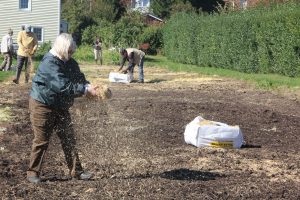Dodge Paddock Beal Preserve is a small oasis in Stonington Borough and is owned by Avalonia Land Conservancy. With tidal wetlands, coastal grassland and a rocky intertidal area, the area has much to offer visitors. The preserve has been the focus of many efforts involving the land trust, CT Dept of Energy and Environmental Protection, Mystic Aquarium and Connecticut Sea Grant. Superstorm Sandy (2012) had significant impacts to the site with both physical (seawall damage) and ecological impacts. Work by Avalonia, Connecticut Department of Energy and Environmental Protection and Mystic Aquarium have focused on restoration and management of the tidal wetland with extensive regrading, Phragmites australiscontrol work and planting of native marsh vegetation. Other significant site work includes grassland management to control invasive plants in upland areas.
Landward of the tidal wetland, numerous questions have arisen with the upland habitats. The Beal Family maintained several beautiful, large gardens as a condition of their land donation. Mrs. Beal recently passed away, so Avalonia needed to determine how to manage a large area of the property bordering the wetlands. Given the proximity of the formal gardens to the marsh, projections of sea level rise of approximately 20 inches by 2050, and observations indicating that the marsh is migrating landward in parts of the Preserve, the creation of a marsh migration buffer seems to be the most prudent approach. With a grant from the National Fish and Wildlife Foundation Long Island Sound Futures Fund, we are moving forward with the creation of such a buffer.
Land Trust Steward, Beth Sullivan, led the clearing of the formal gardens by having local garden clubs, neighbors and friends come in and remove plants which included everything from fennel to canna lilies. More volunteers pulled roots and cleared as much as possible. Then we covered the gardens with black plastic, letting it “solarize” over the summer months. After much planning and determining what plants would work best, we planted the new buffer on Oct 19th. A hardy crew of volunteers rolled up the plastic, raked and leveled the gardens and then sowed seeds with a mix of native coastal grass species. We were also fortunate to obtain seeds for several native species that had been collected several years ago by the New England Wildflower Society as part of their Seeds of Success program. Seeds of native species that were collected locally include switch grass and little bluestem as well as herbaceous perennials such as tall goldenrod. Other donations included milkweed seeds and root balls of joe pye weed from local gardens.

So now we can wait out the winter months and hope for a fruitful spring. While marsh migration with sea level rise is very slow, we are hoping to develop a coastal grassland/meadow that will be an ecologically productive habitat.
